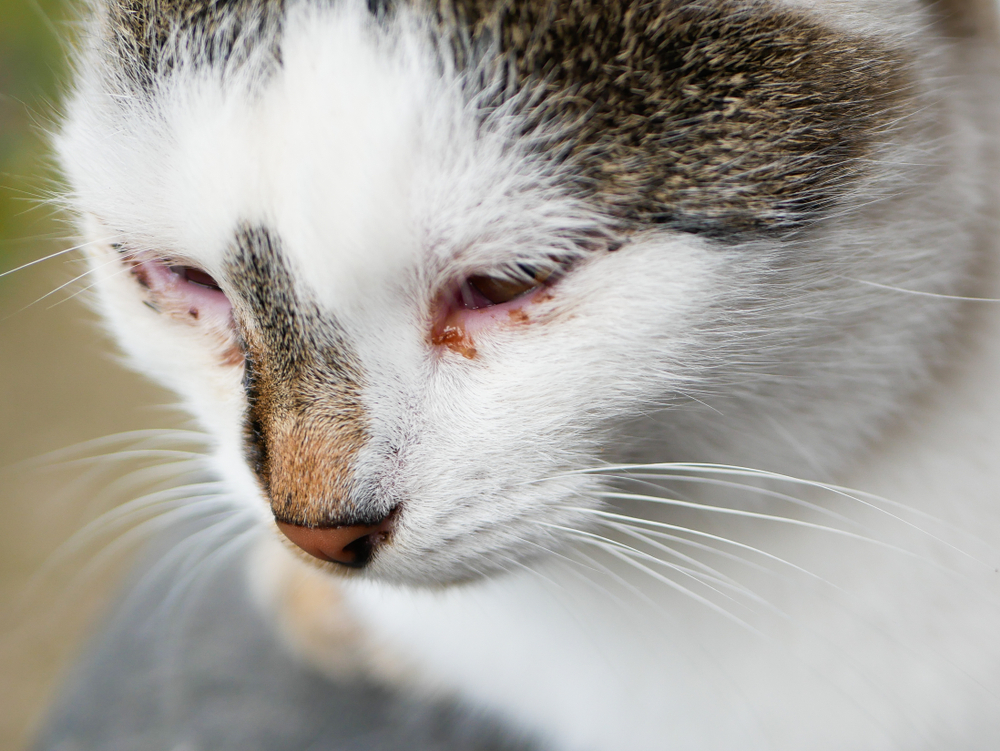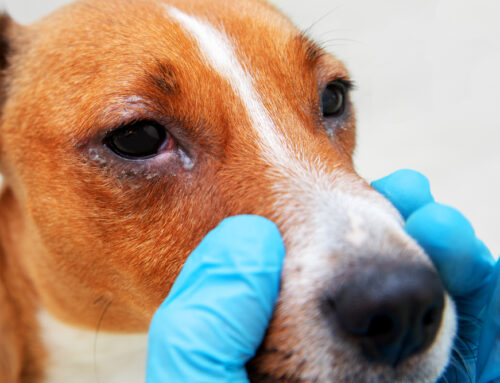In veterinary ophthalmology, we treat many different pet, food, and working animal species, each with their own unique eye structures, features, and functions adapted to their environments. Therefore, the same eye problem can present differently in different animals. But, dacryocystitis, which affects the tear drainage system and can lead to secondary issues, is one condition that affects multiple species. Veterinary Vision Center explains the causes, effects, and treatment options for dacryocystitis in dogs, rabbits, horses, and mice.
What is dacryocystitis in pets?
Dacryocystitis refers to inflammation, infection, abscess, or blockage in the tear drainage system of various species. Glands around the eyes produce tears, which bathe the eye surface and drain through small holes in the eyelids (i.e., puncta) into tiny canals that lead out through the nose, mouth, or sinuses. If the system becomes obstructed, tears spill over onto the face and may stain or irritate the skin. Blockages occur for many reasons, including congenital malformation, trauma, cysts or tumors, or from infection or inflammation.
Dacryocystitis causes in pets
Inflammation or infection inside the tear drainage system most often occurs in the lacrimal sac, which sits below the puncta at the inner eye corner and briefly collects tears before they are diverted through the ducts. Foreign material lodged inside the duct, a local tooth-root abscess, or any obstruction can cause the inflammation. An obstruction predisposes to infection, and infection can also cause obstruction.
Dacryocystitis signs and diagnostics in pets

Signs include excess tearing, redness (i.e., conjunctivitis), and thick discharge from the punctum opening. An abscess may form in the sac or ducts, causing a swelling below the inner eye corner that may rupture and drain through the skin. To diagnose the problem, a veterinary ophthalmologist performs a complete examination to rule out other conjunctivitis or eye discharge causes. Attempts at duct flushing usually fail or cause debris to backflow, confirming the blockage. X-rays or advanced contrast imaging with CT or X-ray can sometimes help determine the infection’s nature and location.
Dacryocystitis treatment in pets
Treatment usually includes topical or oral antibiotics and anti-inflammatories to clear the infection and control swelling. Bacterial culture can help your veterinarian select the most effective antibiotic treatment that will prevent future antibiotic resistance. Sometimes, a flexible tube can be sutured in place inside the ducts to act as a stent during healing and ensure scar tissue doesn’t re-obstruct the duct (i.e., cannulation). Other times, the ducts are permanently damaged, causing tear overflow. This may be a simple cosmetic problem, but if a chronic obstruction is causing recurrent infections or refractory conjunctivitis, surgery can re-route the duct or build a new one.
Pet species differences in dacryocystitis
While most dacryocystitis cases are similar across species, causes and signs can vary, depending on the individual pet’s head shape and structure.
- Dogs — Tear duct malformations and excess tear spillover are common in dogs, but dacryocystitis occurs less frequently. Tear staining is most often observed in brachycephalic (i.e., flat-faced) breeds with large eyes and tight eyelid skin that precludes normal tear drainage. This staining is harmless and doesn’t require treatment, but products designed to clean around the eyes can help prevent stain formation so the dog is more cosmetically pleasing.
- Rabbits — Dacryocystitis is more common in rabbits than dogs, and is often associated with dental abscesses or malnutrition that cause bony changes. Dental disease must be adequately addressed, along with duct flushing and antibiotics. In severe dental disease, the duct can be permanently damaged.
- Horses — Horses also commonly experience dacryocystitis that, because of their outdoor housing and environment, is often caused by foreign material lodged in the duct. Treatment is similar to dogs, including antibiotics, duct flushing, and cannulation. Some horses have abnormally located (i.e., accessory or ectopic) ducts, which can be surgically relocated in some cases.
- Mice — As in rabbits, overgrown or abscessed teeth can lead to infection around the eyes. Younger mice and other rodents can develop a viral infection that affects multiple tear glands surrounding the eye, leading to more chronic and serious dry eye, inflammation, retinal changes, and blindness in severe cases.
Dogs and cats do not commonly develop dacryocystitis, but may have other drainage abnormalities that cause tearing or redness. If you suspect that your pet has a tear duct problem, schedule a consultation with the ophthalmology experts at Veterinary Vision Center.







Leave A Comment